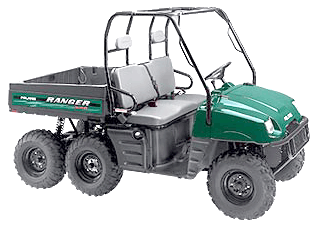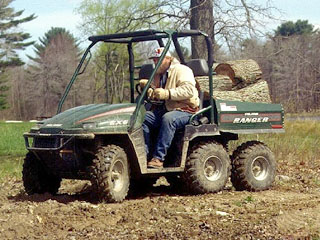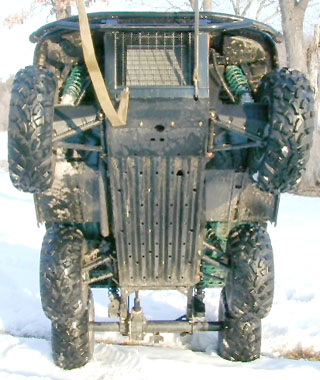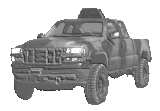|
|
For
participants only. Not for public distribution.
|
Note #18
John Nagle |
A new vehicle option
Small 6-wheel ATVs are rugged, but too slow for the Grand Challenge. But there are bigger ones.
The Polaris Ranger
Here's one with a 40MPH top speed: the Polaris Ranger. This 6x6 machine can reach 40MPH on the flat, fords 27" water crossings, carries about 1000 pounds of load, and goes over a wide variety of terrain. We wouldn't have to do anything to improve its performance as a vehicle except upgrade the fuel tank capacity. It only costs $10,000, so we can have two and not worry too much about breaking one during testing. This looks promising. The speed range and offroad capabilities are well matched to the task.
I've been to Bike World in Sunnyvale to look at one. They had one of the 6 wheel versions on the lot, along with a number of other Polaris vehicles. The 6WD version was new in 1998, but Polaris has been making ATVs of various types for decades. It's made in Minnesota.
 |
Polaris Ranger, 6x6 model Looks like a golf cart. It's not. |
 |
Typical application - a mini-truck for off-road use This is a photo by a user, not a publicity shot. |
 |
Bottom view Note full skid plate
coverage and independent suspension on front and mid axles. |
I've been to Bike World in Sunnyvale to look at one. This isn't a rare vehicle; they're on the lot.
Pro
- Shouldn't have trouble with any of the terrain on the course.
- Real steering; this is not a skid-steer vehicle.
- Faster than most other ATVs. Rated top speed 40MPH.
- Rugged, forgiving of mistakes.
- Easy to repair if damaged.
- Dealers and parts easily available.
- Real suspension on all six wheels, unlike most ATVs. Claimed to be the smoothest ride in ATVs.
- Liquid-cooled engine with radiator.
- 2WD drive mode for on-road operation.
- Can supposedly fit in the back of a pickup truck. But it's a tight fit, and only fits with the tailgate down.
- CMU used a smaller model for one of their robot vehicles.
- Good view from top of roll cage. You can see the front bumper. So we wouldn't need to put a vision system on the front bumper. All sensors would go up high.
Con
- Very basic vehicle. No protection for electronics.
- Manual steering. Needs a big steering actuator.
- No sensors as part of vehicle, not even a speedometer or tachometer. We'd need to instrument the drivetrain and add some basic engine monitoring, at least temperature.
- Very limited electrical output. Small 300W alternator. We'd need an auxiliary power source.
- Rated top speed of 40MPH may be exaggerated. The Ranger is apparently designed to spend most of its time in low range, with a top speed of 18MPH. High range is for flat terrain only. We have to average 20MPH.
- Not street legal. Hard to find places to test on-road.
